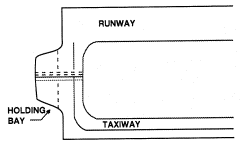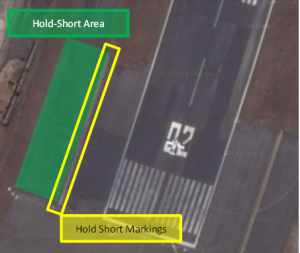The hold short line is something all pilots are familiar with. Something we also vaguely remember for the ground school class with all other airport markings. In Guatemala we only get to see a subset of airport markings and the hold short line is definitely part of it. As straight forward as it seems, I have had “doubts” about the hold-short line and I have observed other pilots probably having similar thoughts. I had the opportunity to discuss this with other pilots and have done some lookup to make sure my comments here are as educated as possible. Let’s get started…
The hold short markings are four lines that separate the runway from the taxiway or another runway. These yellow lines consist of two solid lines and two dotted lines, where the solid lines always can be found on the side of the taxiway.
When taxing from the parking position two the holding position for takeoff, all pilots will stop before that line so that no component of the airplane is over the line, making sure the aircraft is clear of the runway. You can only cross this line with authorization from ATC. Let’s have a look at the runway 02 in La Aurora. It’s hard to make out the markings, but you will notice the holding area is big enough for a smaller plane to make run-ups while a commercial aircraft can still taxi to the runway for takeoff.
The situation is a little different at other runway crossings. As an example, have a look at the taxiway N off the runway that leads directly to the fuel bombs of the “Aeroclub”.
A plane holding correctly at that hold short marking is essentially in the middle of the runway and blocking the runway for other traffic. Surely this is the reason that pilots would go over the line into the taxiway to clear the taxiway. It sounds very kind, but technically is a runway incursion.
This situation should be fairly straight forward I have only seen this couple of times. Here is another situation that I am seeing all the time. As I had mentioned in the introduction, I had thoughts about the correct action around the hold-short markings also. Imagine the following scenario. You just landed on runway 02 and you roll on the runway towards the “Aeroclub”. La Aurora Tower requests you leaving the runway to your left. A commercial plane is taxing down the runway and you realize that if you clear the runway, you will be blocking that traffic as you will be right in front of that aircraft. What makes this situation a little more complex is that you will be changing radio frequencies from La Aurora Tower to Ground Control. This means that you are not in the same frequency as the closing traffic. I understand the urge to leave the taxiway clear and stay on the little path. Again, if a plane is landing on runway 02, this is technically a runway incursion.
Here is an abstract from the FAA AIM.
[…]
Runway Holding Position Markings on Taxiways. These markings identify the locations on a taxiway where an aircraft is supposed to stop when it does not have clearance to proceed onto the runway.
[…]
When instructed by ATC to, “Hold short of (runway “xx”),” the pilot must stop so that no part of the aircraft extends beyond the runway holding position marking. When approaching the runway, a pilot should not cross the runway holding position marking without ATC clearance at a controlled airport, or without making sure of adequate separation from other aircraft at uncontrolled airports. An aircraft exiting a runway is not clear of the runway until all parts of the aircraft have crossed the applicable holding position marking.
[…]
In summary stay entirely clear of the runway before takeoff and after landing, ensuring that no part of your aircraft crosses the line. This places you in the middle of the taxiway. This not only is your right, but obligation. The only exception to this is, when ATC requests you to stop before continuing to the taxiway.
Please let me know your comments!
Happy Taxiing!




The article was modified. Thanks to Michael, who detected a mistake in the key part of tha above article. The article had the sides of the hold-short line wrong. The purpose of the article was to clarify things and not confuse things even more.
If you have the solid line in front of you, you have to stop before the line. If you have the dotted lines on your side, you have to to cross.
Happy to see, someone read this article. Thanks Michael for the correction!
Hello Alex,
I believe I may have some more information to clarify your scenario at the hold short line at the taxi ramp near the fuel bombs. An taxiing aircraft is required to stop at a hold short line ONLY when approaching the line from the side with the solid lines and they have not yet received an ATC instruction to cross the line. However, when approaching a hold short line from the side with the dashed lines, an aircraft is not required to stop and await ATC instruction to cross it. In that situation where an aircraft is taxiing off an active runway, the taxiing aircraft is expected to completely cross the hold short line until every part of the aircraft does not cross the line. Of course in such a situation, an aircraft should only cross the line off of the active runway if and only if the aircraft can do so safely. For example, if the taxiing aircraft cannot move forward off of the active runway because of possible damage due to other ground traffic, then the taxiing aircraft should stop until it can move forward safely, even if it means not clearing the active runway for other arriving or departing aircraft. In that situation, the ATC tower and the other PICs in arriving or departing aircraft share in the responsibility of preventing an incident when an authorized aircraft on the runway has not yet cleared the active runway. ATC should realize the situation and instruct landing aircraft to go around and not clear any waiting aircraft for take off. PICs in those aircraft should also be aware of the runway status. If they see that the runway is not clear they should refuse any ATC instruction that would put their aircraft in danger and notify ATC of the situation and their amended intent or action.
Michael
Thank you very much Michael.
If continuing would cause a collision, you stop, even if you are still on the runway. What if an airliner is taxing towards the south on the west of the runway? A small aircraft just landed and will clear the runway to the west also. The aircraft once off the runway will have to taxi to the south, head-on with the airliner. The airliner is talking to ground control and the small aircraft to the tower frequency until clear of the runway. There is no danger of collision, since both aircrafts are seeing each other. Should the aircraft continue and clear the runway, even it could potentially block the two aircrafts. I would say,”yes”. In this situation it would a good practice to talk to tower and ask if that is what they want you to do, or you could make stay on the runway until being behind the airliner and then get off the runway. If tower doesn’t provide any instructions or is busy, I would continue and clear the runway.
Thoughts?